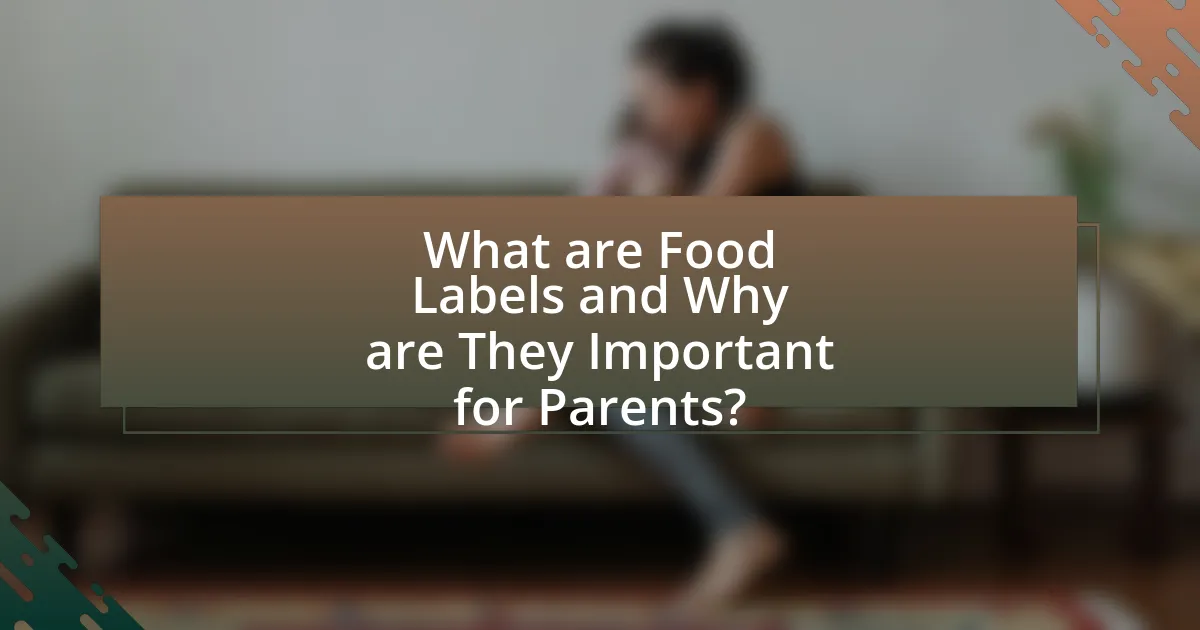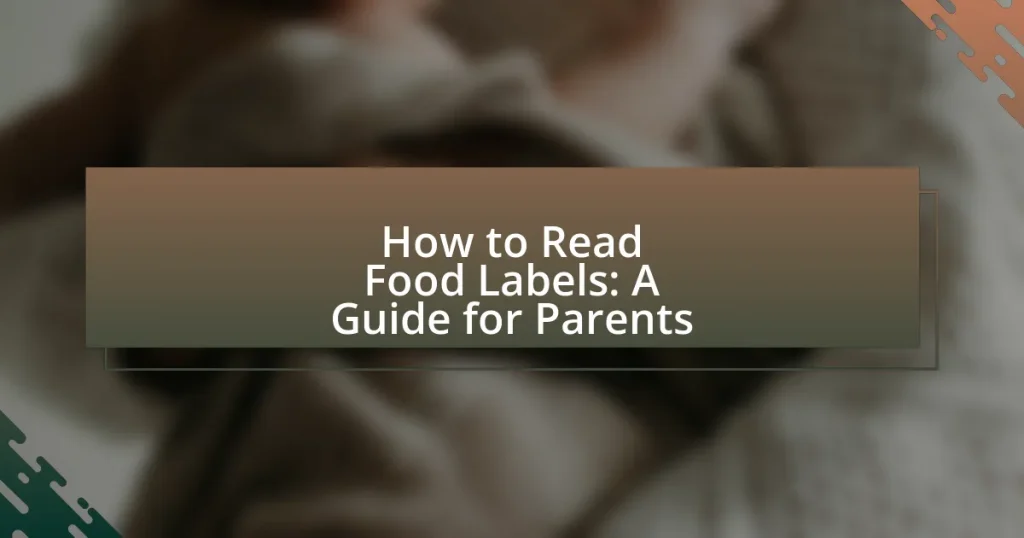Food labels are essential tools that provide detailed information about packaged food products, including ingredients, nutritional content, and serving sizes. For parents, understanding food labels is crucial for making informed dietary choices that support their children’s health and nutrition. The article outlines how food labels can guide parents in selecting healthier options, highlights key components such as serving sizes and allergen warnings, and discusses common misleading claims that may affect food choices. Additionally, it offers practical tips for reading labels effectively and emphasizes the importance of teaching children about nutrition through label literacy.

What are Food Labels and Why are They Important for Parents?
Food labels are detailed descriptions found on packaged food products that provide essential information about the ingredients, nutritional content, and serving sizes. They are important for parents because they help in making informed dietary choices for their children, ensuring that meals are balanced and meet nutritional needs. For instance, food labels indicate levels of sugars, fats, and allergens, which can guide parents in avoiding unhealthy options and potential allergens. According to the U.S. Food and Drug Administration, understanding food labels can significantly impact dietary habits and health outcomes, making them a crucial tool for parents in promoting healthy eating.
How do food labels help in making healthier choices?
Food labels help in making healthier choices by providing essential nutritional information that guides consumers in selecting products that align with their dietary needs. These labels typically include details such as calorie count, serving size, and the amounts of fats, sugars, and essential nutrients like vitamins and minerals. For instance, a study published in the Journal of Nutrition found that individuals who regularly read food labels are more likely to choose lower-calorie and lower-fat options, leading to improved dietary quality. This evidence supports the idea that food labels serve as a valuable tool for informed decision-making, ultimately promoting healthier eating habits.
What key information can parents find on food labels?
Parents can find essential information on food labels, including nutritional facts, ingredient lists, serving sizes, and allergen warnings. Nutritional facts provide details on calories, fats, carbohydrates, proteins, vitamins, and minerals, helping parents assess the healthiness of a product. The ingredient list reveals all components used in the food item, allowing parents to identify any unwanted additives or allergens. Serving sizes indicate the recommended portion, which aids in understanding the nutritional content relative to consumption. Allergen warnings highlight potential allergens, ensuring parents can make safe choices for children with food sensitivities.
Why is understanding food labels crucial for children’s nutrition?
Understanding food labels is crucial for children’s nutrition because they provide essential information about the nutritional content and ingredients of food products. Parents can make informed choices that support their children’s health by interpreting these labels accurately. For instance, food labels indicate levels of sugars, fats, and essential nutrients, which are vital for a child’s growth and development. Research shows that children who consume a balanced diet rich in nutrients are more likely to achieve optimal health outcomes, including better cognitive function and reduced risk of chronic diseases. Therefore, understanding food labels empowers parents to select healthier options, ensuring their children receive the necessary nutrients for their overall well-being.
What are the main components of a food label?
The main components of a food label include the product name, serving size, nutritional information, ingredient list, and allergen information. The product name identifies the food item, while the serving size indicates the recommended portion for consumption. Nutritional information provides details on calories, fats, carbohydrates, proteins, vitamins, and minerals per serving, allowing consumers to assess the healthiness of the product. The ingredient list enumerates all components in descending order by weight, ensuring transparency about what is included. Allergen information highlights potential allergens, such as nuts or gluten, to inform consumers about possible dietary risks. These components collectively help consumers make informed choices about their food.
What does the Nutrition Facts panel tell us?
The Nutrition Facts panel provides essential information about the nutritional content of a food product. It details serving size, calories, and key nutrients such as fats, carbohydrates, proteins, vitamins, and minerals. This information helps consumers make informed dietary choices by comparing products and understanding their nutritional value. For example, the panel specifies the amount of added sugars and dietary fiber, which are crucial for maintaining a balanced diet.
How do ingredient lists inform parents about food quality?
Ingredient lists inform parents about food quality by detailing the components of a product, allowing them to assess nutritional value and safety. Parents can identify whole, natural ingredients versus artificial additives, preservatives, or allergens, which directly impacts their children’s health. For example, a study published in the Journal of Nutrition found that foods with shorter ingredient lists often contain fewer unhealthy additives and are generally more nutritious. This transparency enables parents to make informed choices that align with their family’s dietary needs and preferences.
How can parents interpret serving sizes on food labels?
Parents can interpret serving sizes on food labels by understanding that the serving size indicates the recommended amount of food for one person, which is used to calculate nutritional information. This information is typically listed at the top of the nutrition facts panel and is expressed in common measurements such as cups or pieces. For example, if a label states that a serving size is one cup and the total servings in the package is four, parents can determine that the entire package contains four cups of food. Additionally, parents should note that the nutritional values, such as calories and nutrients, are based on this serving size, meaning that consuming more than the stated serving will increase the intake of those nutrients proportionally. Understanding this helps parents make informed decisions about portion control and dietary choices for their families.
What is the significance of serving sizes in meal planning?
Serving sizes are significant in meal planning because they provide a standardized measure for portion control, helping individuals manage their nutritional intake effectively. By adhering to recommended serving sizes, individuals can better understand the caloric and nutrient content of foods, which is crucial for maintaining a balanced diet. Research indicates that proper portion sizes can prevent overeating and contribute to healthier eating habits, as evidenced by studies showing that people tend to consume more when larger portions are served (Rolls, B.J., 2003, “The role of portion size in the regulation of food intake,” Nutrition Reviews). Thus, understanding serving sizes is essential for making informed dietary choices and promoting overall health.
How can serving sizes affect calorie intake for children?
Serving sizes significantly influence calorie intake for children by determining the amount of food consumed in relation to its caloric content. When serving sizes are larger, children are likely to consume more calories, which can lead to excessive energy intake and potential weight gain. Research indicates that children often underestimate portion sizes, leading to unintentional overconsumption; for example, a study published in the American Journal of Clinical Nutrition found that children who were served larger portions ate approximately 25% more than those given smaller portions. This highlights the importance of appropriate serving sizes in managing children’s calorie intake effectively.

What Common Misleading Claims Should Parents Be Aware Of?
Parents should be aware of common misleading claims on food labels such as “natural,” “organic,” and “low-fat.” The term “natural” is not strictly regulated, meaning products can contain artificial ingredients despite the label. “Organic” claims require certification, but some products may use the term loosely without meeting all organic standards. Additionally, “low-fat” does not always equate to healthy; products may contain high levels of sugar or additives to compensate for reduced fat content. According to the U.S. Food and Drug Administration, these terms can often mislead consumers regarding the actual nutritional value of the products.
How do terms like “natural” and “organic” impact food choices?
Terms like “natural” and “organic” significantly influence food choices by shaping consumer perceptions and preferences. Research indicates that consumers often associate “organic” with higher quality and health benefits, leading to a willingness to pay premium prices; for instance, a study published in the Journal of Consumer Research found that organic labeling can increase purchase intentions by up to 30%. Similarly, the term “natural” can evoke a sense of wholesomeness, although it lacks a standardized definition, which may lead to varying interpretations among consumers. This ambiguity can still drive choices, as many individuals prefer products labeled as “natural” over conventional options, believing they are healthier. Thus, both terms play a crucial role in guiding consumer behavior and decision-making in the food market.
What regulations govern the use of these terms on labels?
The regulations governing the use of terms on food labels are primarily established by the Food and Drug Administration (FDA) in the United States. The FDA enforces the Federal Food, Drug, and Cosmetic Act, which mandates that food labels must be truthful and not misleading. Specific regulations include the Nutrition Labeling and Education Act (NLEA), which outlines requirements for nutritional information and health claims on labels. Additionally, the Fair Packaging and Labeling Act (FPLA) requires that labels provide accurate information regarding the identity and quantity of the product. These regulations ensure that consumers receive clear and accurate information about the food products they purchase.
How can parents differentiate between marketing and nutritional value?
Parents can differentiate between marketing and nutritional value by closely examining food labels and ingredient lists. Food labels often highlight appealing phrases like “natural,” “low-fat,” or “sugar-free,” which can be misleading and do not necessarily indicate a product’s overall nutritional quality. For instance, a product labeled as “low-fat” may contain high levels of sugar to enhance flavor, thus negating its health benefits.
To assess true nutritional value, parents should focus on the Nutrition Facts panel, which provides specific information on calories, macronutrients, vitamins, and minerals. Additionally, reviewing the ingredient list helps identify whole foods versus processed ingredients; shorter lists with recognizable items typically indicate higher nutritional quality. Research from the Journal of Nutrition Education and Behavior shows that consumers who understand food labels make healthier choices, reinforcing the importance of critical evaluation over marketing claims.
What are the implications of added sugars and sodium on health?
Added sugars and sodium have significant negative implications on health, primarily contributing to obesity, cardiovascular diseases, and hypertension. High consumption of added sugars is linked to increased caloric intake without nutritional benefits, leading to weight gain and metabolic disorders. For instance, the American Heart Association recommends limiting added sugars to no more than 6 teaspoons per day for women and 9 teaspoons for men to mitigate these risks.
Similarly, excessive sodium intake is associated with elevated blood pressure, which is a major risk factor for heart disease and stroke. The Centers for Disease Control and Prevention (CDC) states that reducing sodium intake to less than 2,300 milligrams per day can lower blood pressure and improve heart health. Therefore, monitoring added sugars and sodium in food labels is crucial for maintaining overall health and preventing chronic diseases.
How can parents identify hidden sugars in food products?
Parents can identify hidden sugars in food products by carefully reading the ingredient list and nutrition facts label. The ingredient list is ordered by weight, meaning that sugars listed near the top are present in larger quantities. Common names for hidden sugars include sucrose, glucose, fructose, corn syrup, and honey, among others. Additionally, parents should look for terms like “syrup,” “nectar,” and “juice concentrate,” which often indicate added sugars. The nutrition facts label provides the total sugars content, which can help parents assess the sugar level in a serving. According to the American Heart Association, children should consume no more than 25 grams of added sugar per day, making it crucial for parents to monitor sugar intake through label reading.
What are the recommended limits for sodium intake for children?
The recommended limits for sodium intake for children vary by age. For children aged 1 to 3 years, the limit is 1,500 milligrams per day; for those aged 4 to 8 years, it is 1,900 milligrams per day; and for children aged 9 to 13 years, the limit is 2,200 milligrams per day. These guidelines are established by the American Heart Association and the Dietary Guidelines for Americans, which emphasize the importance of reducing sodium intake to prevent health issues such as high blood pressure and cardiovascular disease later in life.

How Can Parents Use Food Labels to Promote Healthy Eating Habits?
Parents can use food labels to promote healthy eating habits by teaching their children to read and understand nutritional information, ingredient lists, and serving sizes. By guiding children to identify key components such as calories, sugars, fats, and vitamins, parents can help them make informed choices that align with a balanced diet. Research indicates that children who are educated about food labels are more likely to choose healthier options, as they develop critical thinking skills regarding their food choices. For instance, a study published in the Journal of Nutrition Education and Behavior found that children who participated in label-reading activities showed improved dietary choices and increased awareness of nutritional content.
What strategies can parents employ when shopping for groceries?
Parents can employ several strategies when shopping for groceries to ensure they make informed choices. First, creating a shopping list based on meal planning helps parents avoid impulse purchases and stick to healthier options. Research indicates that meal planning can lead to healthier eating habits and reduced food waste. Additionally, parents should read food labels carefully to understand nutritional content, including serving sizes, calories, and key nutrients, which aids in making healthier selections. Studies show that consumers who read labels are more likely to choose products with lower sugar and fat content. Lastly, comparing unit prices can help parents find the best value for their money, ensuring they stay within budget while purchasing nutritious foods.
How can meal planning be enhanced by reading food labels?
Reading food labels enhances meal planning by providing essential nutritional information that helps individuals make informed dietary choices. Food labels contain details such as serving sizes, calorie counts, and nutrient breakdowns, which allow for better tracking of daily intake and alignment with dietary goals. For instance, understanding the amount of added sugars or sodium in products can guide parents in selecting healthier options for their families, ultimately promoting balanced meals. Studies indicate that consumers who read food labels are more likely to choose healthier foods, leading to improved overall nutrition and health outcomes.
What role do food labels play in teaching children about nutrition?
Food labels play a crucial role in teaching children about nutrition by providing essential information about the contents and nutritional value of food products. These labels help children understand key concepts such as serving sizes, calorie counts, and the presence of nutrients like fats, sugars, and vitamins. Research indicates that when children learn to read and interpret food labels, they are more likely to make healthier food choices, as evidenced by a study published in the Journal of Nutrition Education and Behavior, which found that children who engaged with food labels showed improved dietary habits. By fostering this understanding, food labels serve as educational tools that empower children to make informed decisions regarding their nutrition.
What are some practical tips for reading food labels effectively?
To read food labels effectively, focus on the serving size, ingredients list, and nutritional information. The serving size indicates the amount typically consumed, which helps in understanding the nutritional values provided. The ingredients list, ordered by quantity, reveals the primary components of the product, allowing consumers to identify any allergens or unwanted additives. Nutritional information, including calories, fats, sugars, and vitamins, provides insight into the healthiness of the food. For instance, a product with high sugar content may not be suitable for children. Understanding these elements enables parents to make informed choices about their family’s diet.
How can parents simplify the process of reading labels for their children?
Parents can simplify the process of reading labels for their children by using visual aids and engaging in interactive discussions about the information on the labels. For instance, parents can create a color-coded system that highlights key components such as calories, sugars, and nutrients, making it easier for children to identify important information quickly. Additionally, involving children in the shopping process and encouraging them to ask questions about the products can enhance their understanding and retention of label information. Research shows that children learn better through hands-on experiences, which reinforces the effectiveness of this approach.
What resources are available to help parents understand food labels better?
Parents can utilize various resources to better understand food labels, including the USDA’s Food Labeling Guide, which provides detailed explanations of label components and nutritional information. Additionally, the FDA offers educational materials and online tools that help consumers interpret food labels effectively. Non-profit organizations, such as the Academy of Nutrition and Dietetics, also provide resources, including articles and workshops focused on label literacy. These resources are designed to enhance parents’ knowledge and empower them to make informed food choices for their families.
